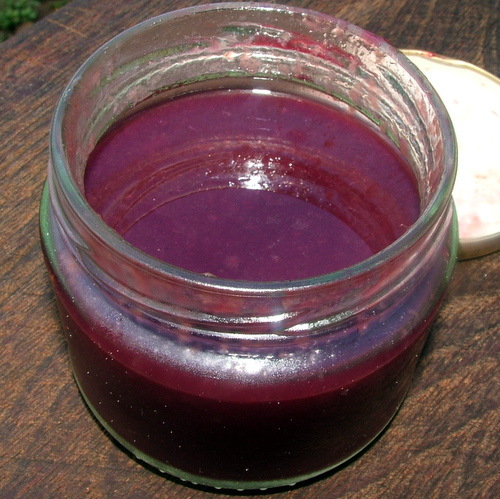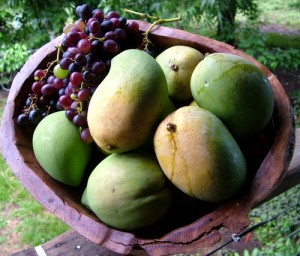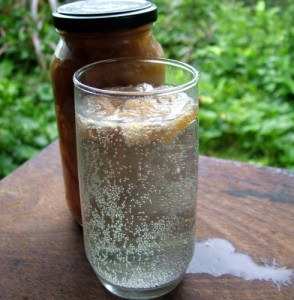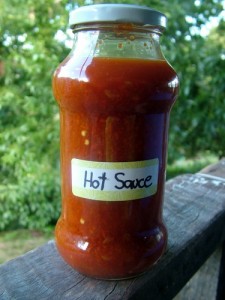The grapes are hanging thick and heavy in our pergola. Such a useful plant. In winter the bare vines let the north western afternoon sun stream onto the verandah, warming the floor and creating a nice spot for proving bread or sitting with a book. In spring the fresh, delicate leaves make dolmades, wonderful lunch or picnic or party food. In summer the vines are thick with leaves blocking the afternoon sun and making cool green shade. And giving us grapes.
I don’t know what variety this vine is – it’s over twenty years old now and my record keeping wasn’t real good then. I do remember that it has been bearing well since my kids were very little, which means it must have borne well in its early years and still keeps going. Grape vines can live for over a century. We prune it every year in autumn, and prune it back heavily every few years. But otherwise it gets no attention – no watering, no mulch, no fertilising.
The bush turkeys feast on them, and drop lots, and some years the grapes are so heavy I have to let the chooks out to clean up under the pergola or we start to smell like a party house after a three day bender. We eat lots straight off the vine. I make schiacciata (just sourdough mixed with grapes and rosemary and turned into focaccia), I put grapes in salads, but in a good grape year, there are still more grapes to deal with.
The permaculture motto is “you don’t have a surplus of slugs, you have a deficit of ducks”, so my standard solution to gluts of anything is to look for more eaters. But grapes don’t travel well, or last long in the corner mailbox in the heat. So I make grape must, or really sapa or saba or mosto cotto depending on which part of the Mediterranean you listen to.
Grape must is red grapes, skins, seeds and all, cooked, strained and reduced down to a thick syrup. Cooking the skins in with it adds the resveratrol, that may or may not be good for everything from heart health to cancer preventative to anti-aging. Real balsamic vinegar is made from it and it is one of those traditional miracle cures for everything, and at the very least it has lots of polyphenols and antioxidants, and, no need for anything else, it is very delicious.
Real balsamic takes years and years and years to ferment and reduce. Expensive fake balsamic vinegar you buy in the supermarket is red wine vinegar with a bit of grape must added to it. Cheap balsamic is just red wine vinegar with syrup and colouring. I don’t have the patience or skill for real balsamic, but making good quality fake balsamic is very easy. In the long days of high summer, we have solar power to waste, so I can leave the slow cooker on all day using free power to cook and reduce the grapes to a thick, dark red syrup that is almost crystalline. Four litres reduced to this little pot of crimson gold.
To make it, I fill the slow cooker with grapes and cook for a few hours with the lid off. Then I use a potato masher to release the juice and keep cooking. Eventually I want to reduce the must to a thick syrup, but at some point, I need to strain out the skins and seeds. The longer the skins are in there, the more resveratrol, but also, the more syrupy the must and the harder it is to strain. I leave it as long as I dare, then pour into an open weave cheesecloth lined colander and squeeze the syrupy juice through the cloth, back into the slow cooker to reduce some more.
At this point, the syrup is properly called saba. It is thick and sweet and it will keep in the fridge for a year easily. Most of it is doled out by the teaspoon in salad dressings, marinades and in recipes where you might use honey. Some though is a splurged treat – grape must on sourdough french toast with yoghurt. Roman decadence.






Does it post well? For instance as a care pack…
I’ve only ever bought this bottled, at a berry farm in Stanthorpe. My absolute favourite way to eat strawberries is drizzled with this heavenly stuff.
The photos are interesting, thank you for showing how you make this.
Would you be able to do this with any type of grapes or just red? The only vine I have at the moment is a Black Muscat, could they be used for this recipe Linda?
Hi Helen, I think it will work with any kind of grape that is sweet – what you are doing is reducing the juice to concentrate the sugars to almost crystalline level. The last of my last year’s supply in the fridge is now solid and like candied honey in texture and still good.
Hello Linda
We make a similar product in the Cape – South Africa. It is called “moskonfyt”, meaning grape must jam. The best Moskonfyt is made with Steen grapes (Chenin Blanc) or Fransdruif (Palomino), but sometimes Hanepoot (Muscat d’Alexandrie) is also used. Traditionally it is cooked in large flat pans over an open fire and the must is flavoured with spices like dried mandarin peel, cloves, cinnamon and dried ginger. It is cooked until the consistency of a thickish syrup, but not as thick as honey or golden syrup. We roughly end up with a quantity that is a quarter of the must we started with. Because it is such a long process, few people nowadays still make it. It has a wonderful taste and lasts for a long time. I have never tried it with red grapes – maybe this year…
Pingback:Summer Fruit Bowl